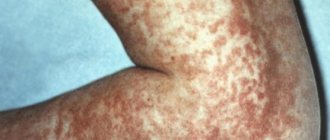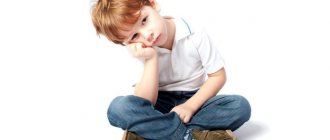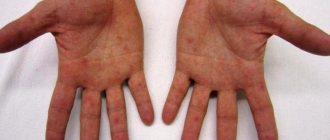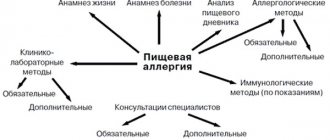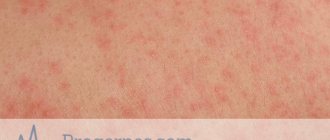Types of rashes, for what reasons they appear
There are dozens of diseases in which the rash always appears, and hundreds more in which it can appear. Only a small part of these diseases are dangerous; if the rash is not accompanied by other symptoms and is not spread over a large area of the body, then it is not dangerous.
All rashes are divided into two groups:
- Primary - appear on healthy skin as a result of a pathological process
- Secondary - appear against the background of primary
Let's take a closer look at the primary rashes that occur most often.
Based on their shape, size, nature of contents, and contours, they can be classified into the following types:
- A tubercle is an element without a cavity, a hard lump that lies deep in the skin.
- A blister is a dense, raised area of skin, pink, and lasts a short time. Occurs from nettle burns and insect bites
- A papule, or nodule, is a cavity-free element with discolored skin, rising above the rest of the skin, resolving without a trace.
- A bubble is an element that has a bottom, a tire and a cavity, up to 0.5 cm in diameter, with liquid contents.
- A blister is a bubble larger than 0.5 cm in diameter
- An abscess is an element with purulent contents.
- Spot - change in skin color
- Roseola is a small pinkish or red spot up to 5 mm in size, does not protrude above the skin level, disappears with pressure
The skin is the largest human organ by area; skin diseases are called dermatoses. The rash can be the result of one or more diseases. The causes of the rash are divided into several groups, depending on the nature of the disease
A small rash on a child’s face may be a consequence of:
- allergies
- infectious diseases
- vascular and blood diseases and other non-communicable diseases
- improper skin care
How to deal with rashes that look like insect bites at home
If a rash of an unknown nature appears, which is not mosquito bites, you can try to alleviate the child’s condition. To do this you need to use lotions. You can add two tablespoons of soda to a glass of water, moisten a piece of bandage in the resulting solution and place it on the area with the rash.
Green tea can have a good effect. A cotton pad is also moistened in it, which is then used to wipe all the places where there are rashes. If the rash is allergic in nature, then you can give the child an antihistamine according to age.
When pimples on a baby’s body can be attributed to prickly heat, then the baby’s body should be wiped with a damp towel dipped in chamomile decoction. You can also take a bath by adding a decoction of string or calendula tincture to the water. Then you should change the baby into clothes made of cotton fabric. If, against the background of the appearance of a rash, the temperature rises and the child’s well-being worsens, then you should call a doctor.
READ ALSO: Scrub for blackheads at home: folk beauty recipes, grandma's recipes, ingredients, instructions for use and reviews
Allergy rash
A small red rash on a child's face may be an allergic reaction. Manifestations of allergies have become increasingly common lately. A theory of the influence of hygiene has been put forward, according to which the increase in cases of allergies is associated with excessive cleanliness and frequent disinfection.
The human immune system is designed in such a way that it must constantly resist antigens. When a child is in conditions close to sterile, this leads to the fact that the immune system reacts to ordinary substances as a threat.
Allergies on the skin can appear in the form of pale pink and red spots. Small groups of rashes on the cheeks, in the eye area, on the chin, pale in color, without itching, often occur in children after the introduction of the first complementary foods.
In this case, complementary foods can be hypoallergenic, for example, zucchini or green apple. This is due to the fact that the child’s body does not have enough enzymes to digest new foods; the digestive system is still developing. Over time, such manifestations will no longer bother mothers and babies.
In severe allergic reactions, the rash is red, the skin is swollen, and itchy blisters appear, which can be located in any part of the body. Allergies can be food, contact or respiratory.
Rash due to infections
The most common disease in children that accompanies a rash is chickenpox. The chickenpox rash appears in the form of small red spots on the face, then throughout the body, the spots turn into papules and fill with fluid. The rash lasts about five days. In this case, the cause of the red rash is the chickenpox virus.
With measles, the rash appears in the form of pink roseolas, then becomes bright, usually abundant, most of all on the face. Until this moment, the patient’s temperature rises to 39 degrees or higher, lethargy appears, appetite disappears, a runny nose with mucus or purulent mucus appears, the eyes are red and watery.
On days 3-5, the temperature returns to normal, the patient feels better, then a day later the first rash appears. On the first day, the rash appears on the inside of the cheeks, then behind the ears, on the face, and on the scalp. Then the rash spreads throughout the body. The rash lasts 7-10 days, then goes away, leaving pigmentation and peeling. Yellow-brown spots on the skin remain for about two weeks, then disappear. Measles is a viral disease. Children are vaccinated against measles, so the disease is rare.
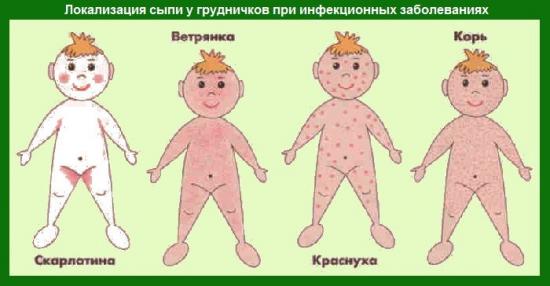
A small red rash on a child's face together with fever, headache, or pharyngitis can be due to rubella. The rash first appears on the face, then spreads throughout the body. The rash spots merge and turn pale. Lasts two or three days, less often five, then disappears without peeling or pigmentation. Usually nothing bothers me. Rubella is a viral disease. The rubella vaccine is given to children at one and seven years of age.
A pinpoint red rash measuring 1-2 mm, prone to coalescence, quickly spreading throughout the body, plus all the typical symptoms of tonsillitis (acute onset, high fever, sore throat, white coating) is a sign of scarlet fever.
The rash appears on the 1-3 days of illness on the cheeks, groin, and sides. A distinctive sign of the rash is that the nasolabial triangle remains free of rashes. The rash lasts for several days, then disappears without a trace.
Scarlet fever is a bacterial disease caused by streptococcus and is treated with antibiotics under medical supervision.
A rash in the form of very bright redness, first on the cheeks, then on the arms and torso, forming “lace” - possibly a sign of erythema infectiosum. In this case, the increase in temperature typical of infections may be absent. This disease is often confused with allergies. The disease is caused by a virus, the disease is not dangerous, lasts 5-7 days, the rash lasts for several days, then goes away without a trace.
Roseola infantum is a common disease. It is also called three-day fever. Caused by the herpes virus. The patient's temperature rises to 39-40 degrees, the febrile state lasts from three to five days, then the condition returns to normal. Then, within a day, a rash appears on the body, starting from the face and neck, in the form of pinkish spots with jagged edges, somewhat elevated above the rest of the skin. There is no itching, the rash lasts from several hours to several days and goes away without a trace.
There are other infections that accompany the rash, including typhoid fever, meningococcal meningitis, infectious mononucleosis, and enterovirus.
In cases of infectious rash, a distinctive feature from others is almost always a rise in temperature, weakness, and less often headache, cough, nausea, and sore throat.
The appearance of a rash on the face and body can also be caused by other pathogens - parasites:
- scabies mite, scabies rash is small, red with sparse papules, twisting tracts are visible
- worms, rash during infestation can be in the form of urticaria, acne, inflamed pimples, accompanied by itching.
When infected with parasites, the temperature rarely rises, or rises to 38, general malaise is extremely rare.
Types of rashes on a child's body
A rash that appears on a child’s body and looks like mosquito bites can have a different manifestation pattern. In this regard, it is customary to distinguish several types of such manifestations:
- Rashes in the form of small spots that are located quite unevenly. More often they appear in separate groups. They are localized in absolutely any area.
- Rash in the form of papules. These spots have a more saturated color, and their minimum size exceeds five millimeters. They may be reddish or pink.
- Vesicle. Another type of rash in which blisters with liquid filling appear.
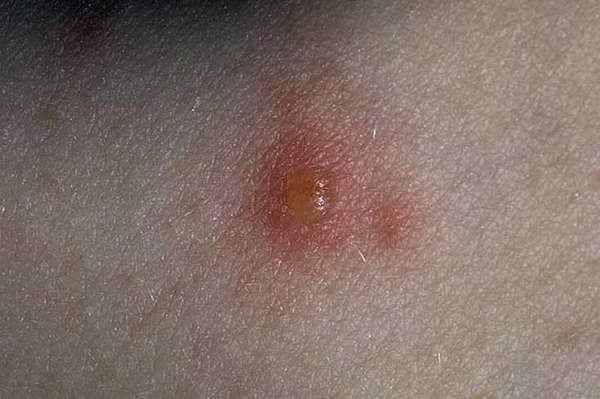
- Sometimes a rash may appear, with clear contours and a purulent core inside.
In addition to this variety, spots that appear on a child’s body can be of different colors: white, red, pink. Their structure can be watery or quite dense. They may look like a blister, papule, nodule, plaque or mosquito bite. Moreover, any rash is always accompanied by additional symptoms that simply must be taken into account in order to make the correct diagnosis.
Blood and vascular diseases and other non-communicable diseases
Diseases that lead to impaired vascular function may be accompanied by small ruptures of skin vessels, and the rash has the appearance of hemorrhages. If there is a red rash on the bridge of the nose on the face, spreading to the cheeks, this is a sign of systemic lupus erythematosus. This is an autoimmune disease; immune cells perceive their own connective cells as antigens and begin to fight them.
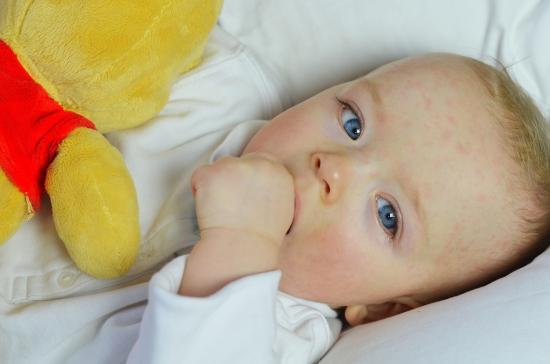
Leukemia and various tumors can provoke skin changes. However, in these cases, skin manifestations will only be a secondary problem. Diagnosis of such diseases is not carried out only by the condition of the skin.
Diabetes mellitus leads to pathological changes in organs and tissues, including the skin. On the face, this can manifest itself in the form of redness of the cheekbones and chin due to vasodilation, such a change is called diabetic rubeosis.
Red, dry, raised papules above the surface of the skin, merging with each other, are a sign of psoriasis. Psoriasis is diagnosed in 2-4% of the population, every third patient indicates the first symptoms before the age of 20. The nature of the disease is not clear; it is assumed that it is based on a dysfunction of the immune system.
How to determine what kind of rash a child has?
It is extremely difficult to independently make a diagnosis in the presence of skin defects. The best way to find out what kind of rash a child has is a consultation with a pediatric dermatologist or pediatrician. Sometimes parents accurately determine the cause of the rash on the baby’s bottom, especially if symptoms accompanying a specific disease are observed, for example, chickenpox or rubella.
READ ALSO: 3-step program ROYAL SKIN LET IT CO 3-STEP NOSE PACK system for cleaning pores from blackheads - “♫A real fight against blackheads from ROYAL Vic goes on the hunt BEFORE photo! Not a very aesthetic picture♫" | Customer Reviews
Red rash on baby's bottom
Most skin pathologies in the buttock area manifest themselves in the form of the described elements. A reddish, pink, scarlet rash on a child’s bottom can be a symptom of both a banal violation of hygiene rules and local or systemic diseases. The described type of defects is observed mainly in dermatitis, prickly heat and allergies, accompanied by severe itching and swelling of the skin. To confirm your suspicions you should:
- Pay attention to the baby's hygiene.
- Track his (or nursing mother's) diet.
A severe rash on the child’s bottom, its spread to other parts of the body, accompanying cough, fever, bowel movements and other symptoms require an accurate diagnosis. Pathological elements may indicate infection, helminthic infestation, or inflammation of internal organs. With such signs, you should immediately contact your pediatrician and undergo the prescribed tests. Self-medication is dangerous.
White rash on baby's bottom
Infants sometimes develop small superficial pustules with a light apex without additional symptoms. These rashes on the buttocks of a child, especially a newborn, are the norm and indicate that the child’s body is adapting to bacteria and fungi in the environment and colonizing the skin with microflora. They will disappear on their own within a week.
In other cases, a white rash on the butt signals a purulent lesion of the epidermis. The diagnosis is established depending on the body temperature, the baby’s well-being, and the presence of specific signs. Such a rash on a child’s bottom should be treated only under the supervision of a specialist. It can be provoked by pathogenic bacteria, viruses, fungi and parasites in the digestive system. It is impossible to determine the causes without laboratory tests.
READ ALSO: Pimples on the nose
Dry rash on baby's bottom
Irritation, peeling, and roughening of the skin are characteristic of allergic manifestations. If a child has a rash of this nature on the bottom, you should:
- Exclude from the menu of the nursing mother and baby all foods to which hypersensitivity may occur.
- Gradually expand your diet by adding one product per day. If there is an allergy, the baby will immediately react to the irritant.
- Additionally, it is recommended to change the child’s clothes and underwear to natural fabrics and wash his things with special products.
- When the above measures do not help, and the baby continues to suffer from a dry rash on the butt, you need to consult a pediatrician.
The child has a rash on the bottom and fever
Fever and fever, or a rise in the thermometer to subfebrile levels indicates an inflammatory process in the body. Skin rashes on the buttocks are simply a symptom of a more serious infection of an infectious nature. This clinical picture is characteristic of chickenpox, rubella, measles, and other viral diseases. You should not wait for the pathology to progress; it is important to immediately visit a pediatrician.
Rash due to improper care
If the temperature regime and the rules of daily hygiene are not observed, the child may experience the following problems:
- prickly heat
- diaper rash or diaper rash
All small children will develop some kind of rash.
Prickly heat
Heat rash is an especially common problem - skin irritation due to overheating. In young children, the sweat glands are not yet fully developed, which leads to delayed sweating. The rash with prickly heat is small, often pimples with liquid, located in clusters, the skin in the area of the rash is red, but if the irritation is not severe, the skin may remain its normal color.
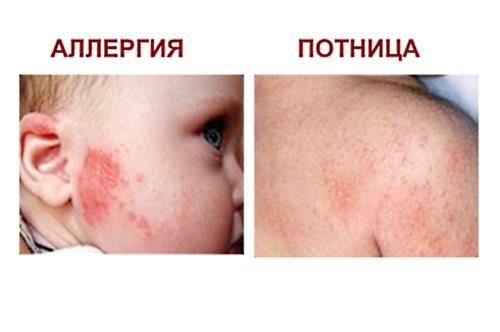
Miliaria can appear on the face if the child sweats under a hat or while sleeping for a long time without changing the position of the head. Most often, prickly heat is located in skin folds.
Diaper dermatitis
This is an inflammation of an area of skin due to exposure to unfavorable factors; the skin is bright red and painful; in young children, diaper rash most often occurs on the buttocks and groin. Exposure to friction, overheating, and prolonged contact with urine and feces lead to damage to the delicate skin of babies, which in turn leads to dermatitis.
In newborns, some types of rash are considered common.
Hormonal rash
It is most often located on the face and scalp in the form of small reddish pimples with a yellowish or white dot in the center, disappearing in one place, they appear in another, not dangerous, goes away by three months or earlier.
Erythema toxicum of the newborn
The rash appears in the first days of life in the form of red spots of various sizes; gray-yellow tubercles appear in the center of the spots, most often located around the joints of the arms and legs. It is not dangerous and usually goes away in 1-2 weeks.
The appearance of a rash on a child’s face does not always indicate a dangerous disease. When parents understand why this rash appeared, they become calmer.
If a month old baby has a small rash on his face, what measures should parents take?
- Determine the nature of the rash - severe or not, with or without itching, whether the child is worried or not.
- Check the temperature and assess the general condition of the child - if everything is normal, then you can observe the rash for a while
- If the rash is caused by improper care, then eliminate all adverse effects.
- If the child’s general condition is impaired and the rash is accompanied by fever, call a doctor immediately.
Treatment of prickly heat and diaper dermatitis boils down to the fact that the child must be bathed every day, the water temperature should be 34-36 degrees. You can add a decoction of string or chamomile to the water, but this is not necessary. When bathing, use soap once a week, this is enough. Leave the child without clothes more often, use high-quality soft diapers, and change them in a timely manner. Apply talc, powder or cream to the rash if the skin dries out. The most important thing is not to overheat the child, the room temperature should be between 20-22 degrees, this is what all pediatricians advise.
Allergy: forms of its manifestation
Due to the fact that children's immunity is quite vulnerable, any external manifestations, as well as nutrition, can cause allergies, which manifest themselves in the form of a rash or red spots of various etymologies. A characteristic feature of all forms of allergies is unbearable itching.
The rashes resemble nettle burns, which is why they are called “urticaria.” At best, blisters will cover the head, torso, arms and legs, and groin folds. At worst, the allergen can cause Quincke's edema, when it becomes impossible to breathe due to severe swelling of the larynx. Despite the fact that the disease lasts only 1-2 days, the rashes constantly disappear and new ones form, and the child’s red spots on the body itch quite intensely.





